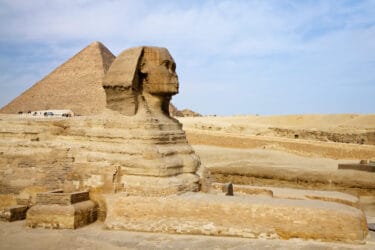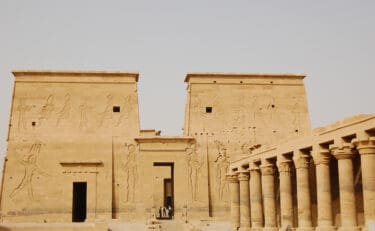The Nile river—iconic and life-giving, it has been the center point of Egyptian civilization for thousands of years. Cruising the Nile is an important part of any trip to Egypt whether you’ve been on a luxury Egypt tour before or you’re considering an Egypt private tour package for the first time, we can’t recommend a more perfect experience than cruising the Nile between Luxor and Aswan. Over a leisurely few days of lavish relaxation, you’ll encounter ancient wonder after wonder as you sail past palm-fringed farmlands and sweeping sand dunes, with the Nile glittering all around under the brilliant Egyptian sun. If you’re joining us on one of our Egypt vacations 2021, let’s take a look at the sensational sites you’ll see on a Nile river cruise.
East Bank of Luxor
Our journey begins in Luxor, once the seat of the ancient city of Thebes. Before we even set out on our cruise, there are many incredible things to witness in this immediate area. Here, we will spend some time getting acquainted with the mighty Nile, as ferries shuttle us back and forth between Luxor attractions on the West and East banks of the river.
On the eastern bank of Luxor, you’ll find a thorough mix of ancient, historic, and modern all standing side by side. Take a step into Egypt’s colonial past with a visit to the Sofitel Winter Palace Hotel, Luxor’s famous riverside luxury resort and one of the best historic hotels in Egypt. Founded in 1905, the palatial property later became the center of the media sensation surrounding Howard Carter’s excavation of King Tutankhamun’s tomb in the 1920s in the Valley of the Kings, as incremental updates to the dig were announced to the multinational press teams posted there.

Steps away from the hotel is the imperial Luxor Temple, the 14th-century BC complex constructed not for a specific deity, but rather for the elevation of the pharaoh to godhood during the Festival of Opet. Built primarily by Tutankhamun and Ramesses II (you’ll find his image widespread in the statuary here), the temple’s often-pictured fortified front wall gives way to dozens of immense columns receding into the temple’s furthest chambers—an especially striking scene to stroll through during the beautifully illuminated evening tours.
Once connected to Luxor Temple by a 3-kilometer avenue lined with sculpted sphinxes, the vast Karnak Temple Complex is an enormous, monumental religious compound, rivaled in size only by the temples at Angkor Wat. Construction at Karnak began during the reign of Senusret I in the 20th century BC and continued for nearly two thousand years, yielding a sprawling multitude of elaborate and immense monuments—like the Great Hypostyle Hall, which features a dozen sandstone columns topping out over 20 meters tall, among over a hundred others of lesser height.

West Bank of Luxor
Taking a ferry across the mighty Nile river, we arrive in the deserts of the West Bank of Luxor, full of timeless historical wonders. Buried beneath the windblown sands and tunneled into the hillsides are over 60 royal tombs from ancient Thebes’ distant past, comprising the renowned Valley of the Kings. With relic-laden sites dating back as far as the 1500s BC, this necropolis has been a hotbed of archeological study for decades, and is well known for its famous tombs—like the gilded burial chamber of young King Tutankhamun, or the brilliantly illustrated passages of Ramesses IV’s tomb.
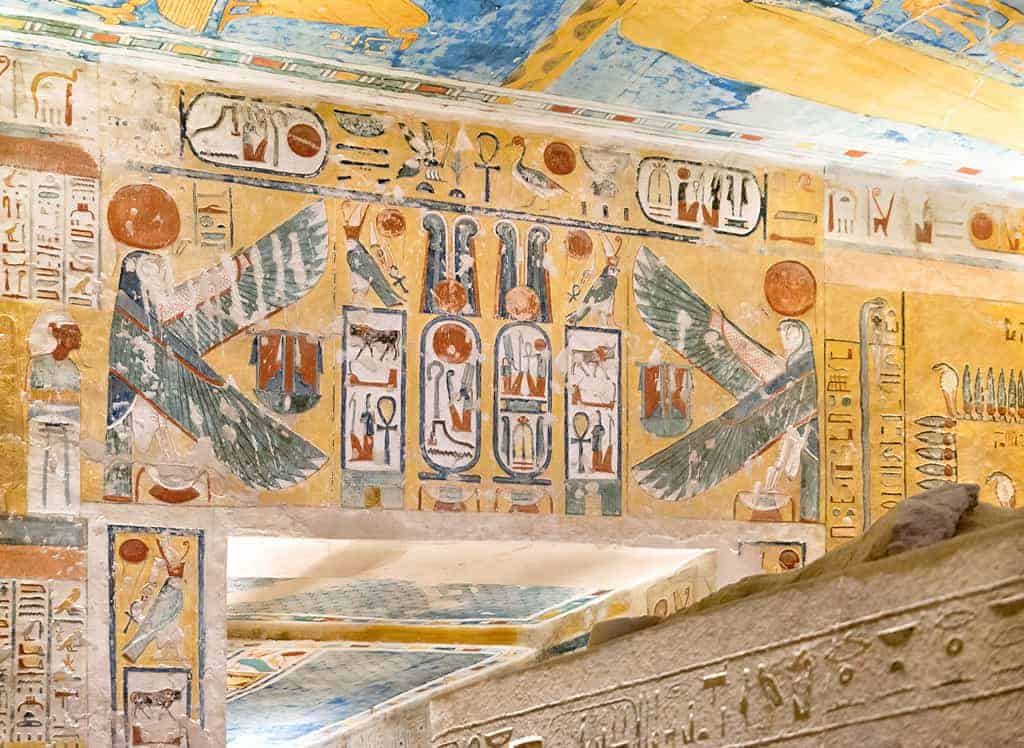
An even greater number of regal burials lay in the next wadi over the hills, just southwest from the Valley of the Kings—another necropolis for nobility known as the Valley of the Queens. Home to over 90 tombs, the Valley of the Queens is the secluded resting place for its historical female namesakes as well as princes, princesses, and other high nobles. Of particular note here is the unmissable tomb of Queen Nefertari, a jaw-droppingly vibrant and ornamented crypt often called the “Sistine Chapel of Egypt.”
Further wonders abound in the area—the prosaic-but-preserved worker’s village at Deir al-Medina and the well-appointed Tombs of the Nobles, the commanding Mortuary Temple of Queen Hatshepsut, and the gargantuan Colossi of Memnon. It can all be a lot to see on a group tour, but it’s a cinch when you’re on our Egypt custom luxury tours.

Temple of Khnum at Esna
Departing Luxor on the river Nile, you’ll cruise upstream towards Aswan on your luxury Egypt tour—about 30 miles away, we encounter the modern city of Esna, which holds a partially open secret beneath its lands. During Ptolemaic and then later Roman rule, a temple was built here to honor Khnum, the goat-headed god of the Nile who created the world’s peoples on his potter’s wheel. Curiously, the temple was constructed almost 10 meters below ground—and then, sometime after the 3rd century AD, completely abandoned. Esna temple is one of best off the beaten path temples in Upper Egypt.
As almost two thousand years of shifting sands covered the temple, the fledgling city of Esna—Latopolis, as it was known back then—grew overtop the forgotten shrine. Today, the majority of the temple is still buried under the present-day city, but the beautifully preserved hypostyle hall has been excavated and opened to the public.
Inside, the stone roof is held twelve meters overhead by two dozen stout columns, each decorated in its own unique style of architectural flourish. The ceiling bears illustrations of ancient Egyptian astronomy alongside Roman zodiac imagery, and texts inscribed on the columns cover details of the religious festivals in Latopolis and the emperors’ meetings with the gods. Ask your guide to help you decipher the meanings of the other idiosyncratic inscriptions found on the walls here—including atypical hymns to Khnum and hints at other nearby, as-yet-undiscovered temples.
Edfu Temple
A little further up the Nile from Esna, a similar story plays out in grander fashion. At Edfu, silt from the rising Nile and drifting dunes from the desert covered a Ptolemaic temple for centuries, while the city in the area developed above the blanketed ruins. When excavations were undertaken in the mid-19th century AD, the discovery waiting underneath the protective sands was phenomenal.
The now-unearthed Edfu Temple remains the second-largest temple in all of Egypt, and is arguably the best-preserved of any ancient Egyptian structure. A massive pylon fronts the complex, a sheer stone wall jutting skyward over 30 stories, emblazoned with oversized reliefs of Ptolemy XII Neos Dionysos smiting his enemies. The entryway through the fortification is stoically guarded by two immense stone falcons—representations of Horus, the falcon-headed god to whom the compound is dedicated.

Built over the course of almost 200 years beginning around 237 BC, the particulars of the temple’s quotidian operations and construction are well known due to the excellent state of the innumerable inscriptions covering the walls. Just off one side of the capacious hypostyle hall—a majestic sight in its own right—a library room sits without its bound collection, but with the full catalog of its ritual texts etched by title onto the walls. Across the way, laboratory chambers provided spaces for making sacred salves and oils, with ingredient lists and recipes carved in detail directly into the built stone. At the heart of the temple, hieroglyph-covered walls surrounding the inner sanctuary describe the temple’s construction and history—these Building Texts continue at length on the far exterior walls, and describe the functions of the twenty-odd rooms throughout the complex, from the vestry to the river-measuring Nilometer.
Between the timeline-shifting ambience created by the incredibly intact ceilings and the wealth of information to digest, you’ll want to slow down and enjoy every aspect of the experience at Edfu Temple. With our Egypt private tour packages, take all the time you need, and let your private Egyptologist guide unravel the stories written all around you.
Temple of Kom Ombo
With massive sandstone pillars standing tall atop a rising riverside dune, the Temple of Kom Ombo is an unmissable sight. Though earthquakes and flooding—not to mention later stone-borrowing construction projects—have ravaged a great deal of the complex, this towering triple colonnade entryway remains marvelously intact, and provides the first hint at the curious and unique design of the doubled Temple of Kom Ombo.
Unusual among any contemporary designs, the Temple of Kom Ombo was dedicated to two separate deities, and was built symmetrically along a central axis to honor them both equally under one roof. The three-columned entrance of the temple splits the complex neatly in two along the middle line of columns, delineating two nearly identical halves—each complete with mirrored antechambers, hypostyle hallways, and sanctuary rooms for the revered gods.
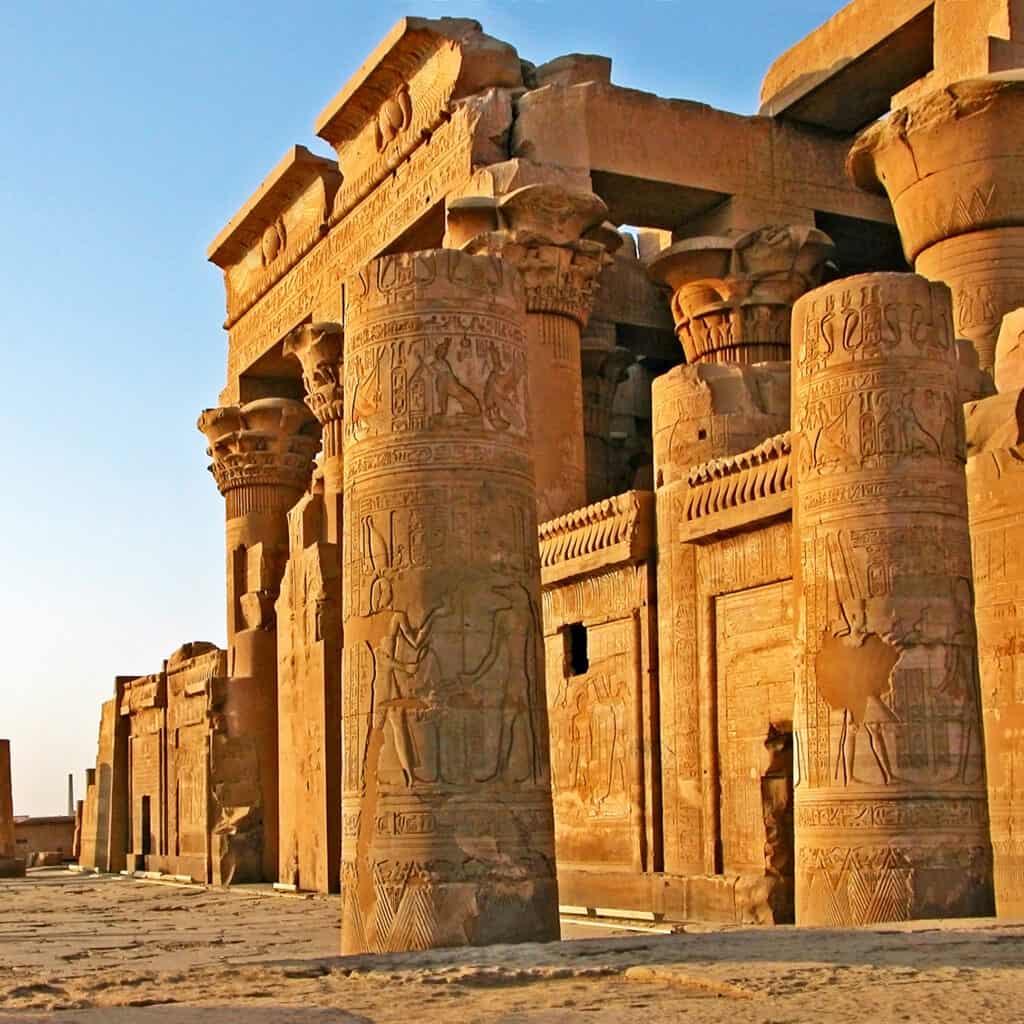
The northern side of the temple is the purview of the falcon-headed god Haroeris, or Horus the Elder, who is glorified in numerous stone reliefs alongside his wife Tanesetnofret and son Panebtawy. On the southern half of the temple, inscriptions and illustrations honor Sobek, the crocodile-headed god of fertility and creation, also featured with his consort Hathor and son Khonsu. Pictured throughout the complex are the Ptolemaic kings, from Ptolemy VI Philometor to Ptolemy XIII Theos Philopator, who built the relatively young structure during the 1st and 2nd centuries BC.
Before departing, be sure to duck into the intimate and informative Crocodile Museum, featuring just a few of the hundreds of mummified reptiles found interred around the temple grounds. Check out our post about the animals of ancient Egypt.
Aswan
We reach the end of our luxurious Nile cruise as we approach the bustling city of Aswan, where the lively merchant hub holds sway over the river’s first cataract. This was the southernmost reach of ancient Egypt, a borderlands city from which military campaigns were launched, trade flourished, and the Nile breathed life into the rest of the nation.

First we’ll make our way past the city to the island of Agilika, where rests the Temple of Isis—the relocated Temple of Philae. A tour to Phiale temple is one of the top tours to do in Aswan. This last example of classical Egyptian architecture was first erected in 690 BC and originally stood further south in a watery expanse that was once the island of Philae. The completion of the first Aswan dam in 1902 changed the temple’s locale from a rocky outcrop into a seasonally submerged site, at times offering tourists the chance to float through the colonnaded courts of Isis in a dahabiya. With the construction of the Aswan High Dam in the 1960s, the temple would have faced an Atlantean fate—were it not for an enterprising engineering project that relocated the entire 20,000-ton temple downstream to the island of Agilika.
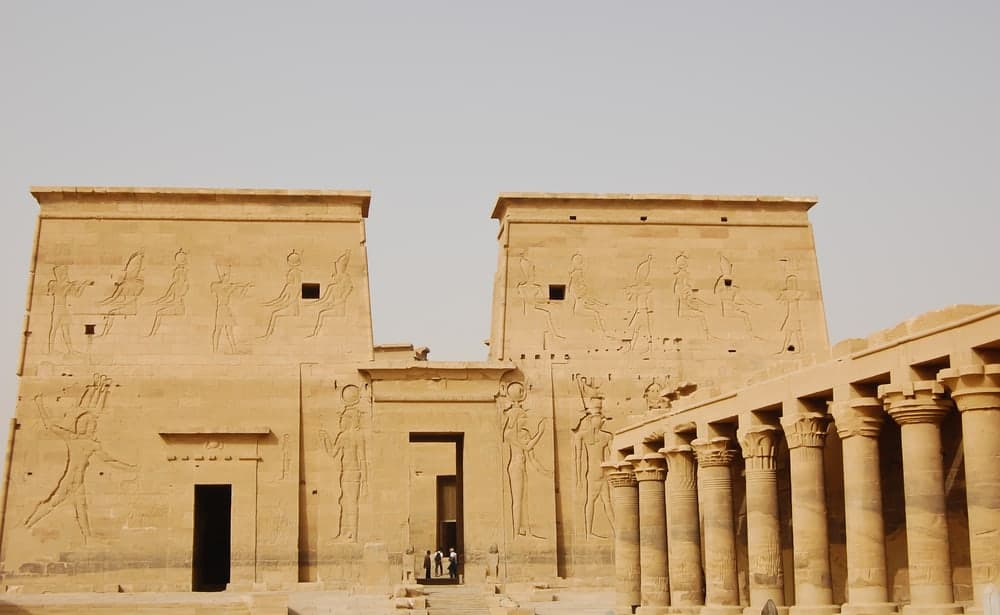
Now, with its 40,000 blocks reassembled stone by stone, tourists can again walk through the 18-meter entrance pylon and explore the column-studded courtyard on foot. While the temple to Hathor just outside of the main hall was likely a cooperative construction, the many Christian crosses etched over older inscriptions in the Temple of Isis show the change in use of the structure over the years. On the island’s eastern edge, frame up the picture-perfect Trajan’s Kiosk, an iconic yet uncompleted temple made famous by Victorian-era painters.

Back in town, the trade city’s largest market is a constant whirlwind of activity and ado. You can find anything and everything here, from Nubian handicrafts to shockingly “lifelike” recreations of those mummified crocodiles—plus, more spices than you likely knew existed and thirst-quenching hibiscus tea. Check out our post about the Nubian monuments and Nubian people.
That’s a quick look at the temples and treasures that you’ll see while traveling the Nile between Luxor and Aswan. Looking to circumvent the cruising crowds? We can arrange to have a dedicated driver escort you by private car to each of these sites on your own personal schedule—no nautical timetables required. Your incredible vacation is designed exactly how you’d like it on our Egypt best tours.
Happy Travels!

